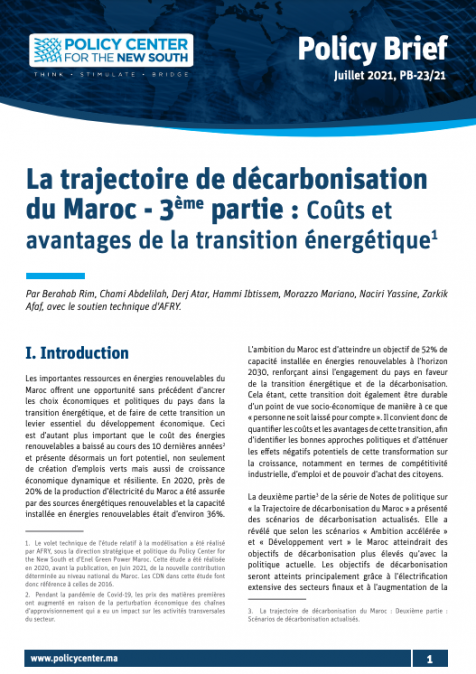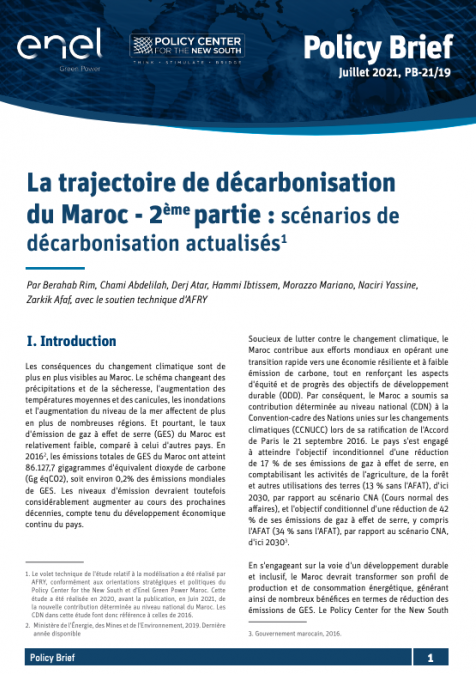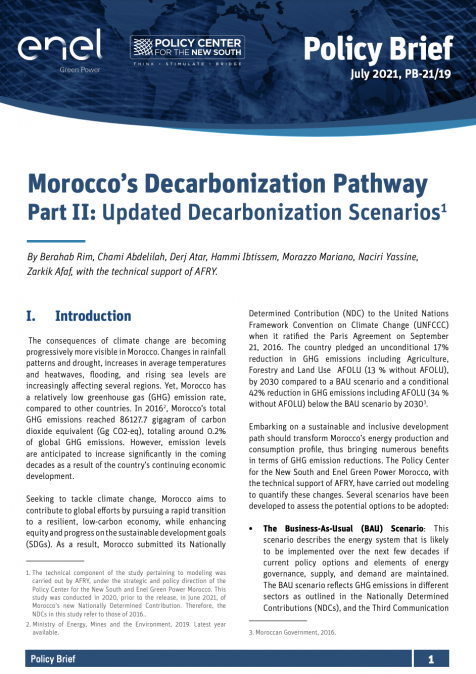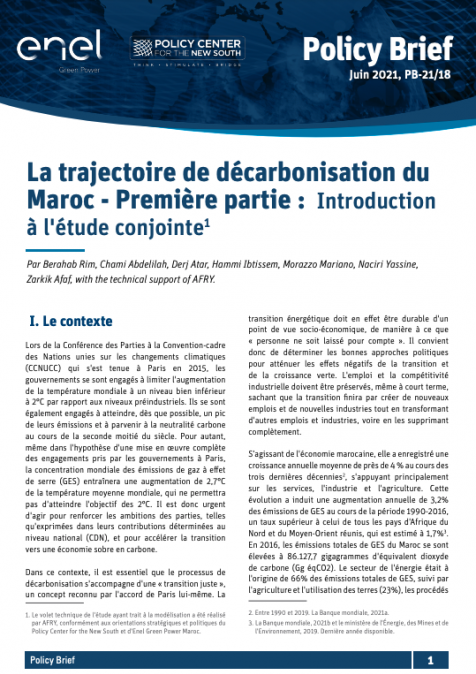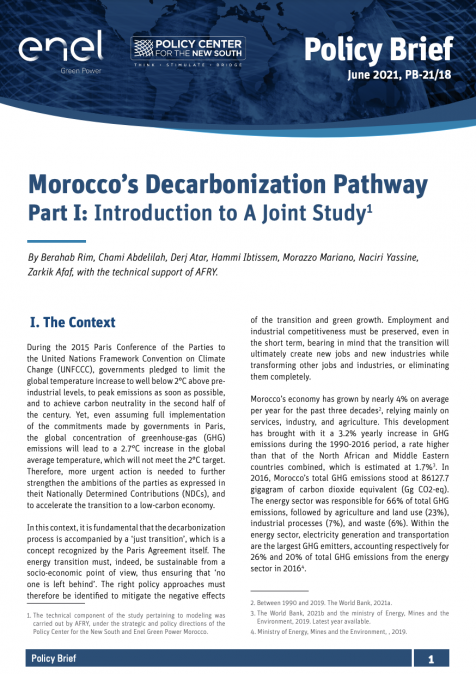Président
- Nobumitsu Hayashi, Gouverneur, Banque japonaise pour la coopération internationale (JBIC)
Présentateur
- Rajat Nag, Distinguished Fellow, Emerging Markets Forum (EMF)
Discutants
- María Eugenia Brizuela de Avila, Directrice, Inversiones Vision
- Larabi Jaïdi, Senior Fellow, Policy Center for the New South (PCNS)
- Abdoulie Janneh, directeur exécutif et membre du conseil d'administration, Fondation Mo Ibrahim
- Djoomart Otorbaev, ancien premier ministre du Kirghizstan
- Sommai Phasee, président de l'Association thaïlandaise du marché obligataire
Lancement de la dernière publication de la FEM : "From Here to Denmark ...the importance of institutions for good governance" par Rajat Nag et Harinder Kohli
RELATED CONTENT
-
AuthorsChami AbdelilahDerj AtarHammi IbtissemMorazzo MarianoNaciri Yassinewith the technical support of AFRYJuly 9, 2021Les importantes ressources en énergies renouvelables du Maroc offrent une opportunité sans précédent d’ancrer les choix économiques et politiques du pays dans la transition énergétique, et de faire de cette transition un levier essentiel du développement économique. Ceci est d’autant plus important que le coût des énergies renouvelables a baissé au cours des 10 dernières années2 et présente désormais un fort potentiel, non seulement de création d’emplois verts mais aussi de croissan ...
-
AuthorsChami AbdelilahDerj AtarHammi IbtissemMorazzo MarianoNaciri Yassinewith the technical support of AFRYJuly 9, 2021Les conséquences du changement climatique sont de plus en plus visibles au Maroc. Le schéma changeant des précipitations et de la sécheresse, l'augmentation des températures moyennes et des canicules, les inondations et l'augmentation du niveau de la mer affectent de plus en plus de nombreuses régions. Et pourtant, le taux d'émission de gaz à effet de serre (GES) du Maroc est relativement faible, comparé à celui d'autres pays. En 20162, les émissions totales de GES du Maroc ont atte ...
-
AuthorsChami AbdelilahDerj AtarHammi IbtissemMorazzo MarianoNaciri Yassinewith the technical support of AFRYJuly 9, 2021The consequences of climate change are becoming progressively more visible in Morocco. Changes in rainfall patterns and drought, increases in average temperatures and heatwaves, flooding, and rising sea levels are increasingly affecting several regions. Yet, Morocco has a relatively low greenhouse gas (GHG) emission rate, compared to other countries. In 20162, Morocco’s total GHG emissions reached 86127.7 gigagram of carbon dioxide equivalent (Gg CO2-eq), totaling around 0.2% of glo ...
-
 AuthorsJuly 7, 2021The world faces a huge shortfall of infrastructure investment relative to its needs. With a few exceptions, such as China, this shortfall is greatest in emerging and developing countries. The G20 Infrastructure Investors Dialogue estimated the volume of global infrastructure investment needed by 2040 to be $81 trillion, $53 trillion of which will be needed in non-advanced countries. The Dialogue projected a gap—in other words, a shortfall in relation to the investment needs foresee ...
AuthorsJuly 7, 2021The world faces a huge shortfall of infrastructure investment relative to its needs. With a few exceptions, such as China, this shortfall is greatest in emerging and developing countries. The G20 Infrastructure Investors Dialogue estimated the volume of global infrastructure investment needed by 2040 to be $81 trillion, $53 trillion of which will be needed in non-advanced countries. The Dialogue projected a gap—in other words, a shortfall in relation to the investment needs foresee ... -
July 7, 2021Otaviano Canuto, Policy Center for the New South The contrast between the scarcity of investments in infrastructure – particularly in non-advanced economies – and the excess of savings invested in liquid and low-return assets in the global economy deserves to be confronted. Greening inf...
-
June 30, 2021Otaviano Canuto, Policy Center for the New South The growth and productivity performance of emerging market and developing economies since the 2008 global financial crisis failed to repeat the achievements of the previous decade. Besides frustrating expectations that they might become t...
-
AuthorsChami AbdelilahDerj AtarHammi IbtissemMorazzo MarianoNaciri Yassinewith the technical support of AFRYJune 28, 2021Lors de la Conférence des Parties à la Convention-cadre des Nations unies sur les changements climatiques (CCNUCC) qui s'est tenue à Paris en 2015, les gouvernements se sont engagés à limiter l'augmentation de la température mondiale à un niveau bien inférieur à 2°C par rapport aux niveaux préindustriels. Ils se sont également engagés à atteindre, dès que possible, un pic de leurs émissions et à parvenir à la neutralité carbone au cours de la seconde moitié du siècle. Pour autant, m ...
-
AuthorsChami AbdelilahDerj AtarHammi IbtissemMorazzo MarianoNaciri Yassinewith the technical support of AFRYJune 28, 2021During the 2015 Paris Conference of the Parties to the United Nations Framework Convention on Climate Change (UNFCCC), governments pledged to limit the global temperature increase to well below 2°C above pre- industrial levels, to peak emissions as soon as possible, and to achieve carbon neutrality in the second half of the century. Yet, even assuming full implementation of the commitments made by governments in Paris, the global concentration of greenhouse-gas (GHG) emissions will ...
-
Souha Majidi & Uri DadushJune 25, 2021The 46th President of the United States, Joe Biden, has been in office for nearly five months, marking a great return of the Democrats to the White House, as well as a strong resurgence o ...
-
June 23, 2021There remains tremendous uncertainty and prospects of a post-pandemic recovery vary greatly across countries, as it is bound to happen at different paces. And the divergence of per capita incomes in the world is rising as an aftermath of the pandemic. The pandemic will leave scars in la...

